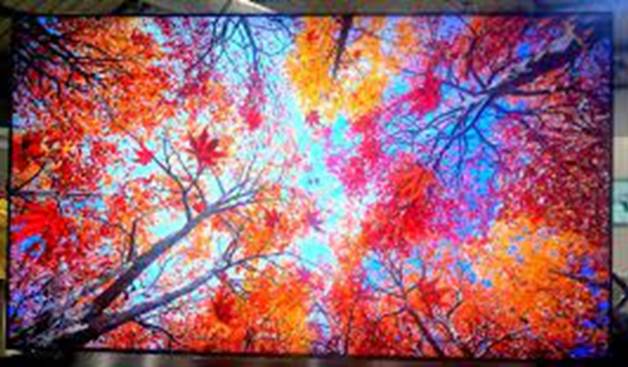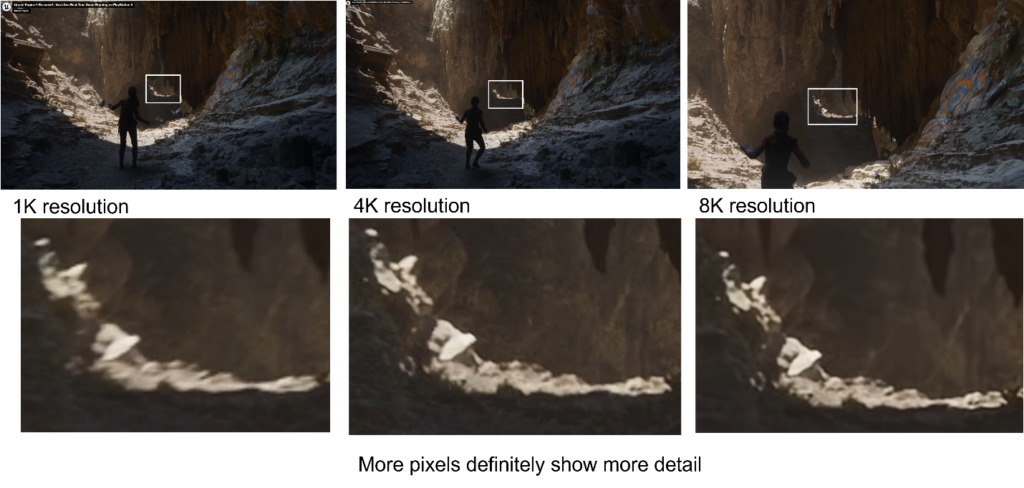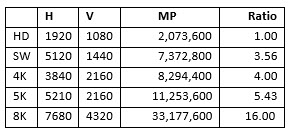What is preventing users from embracing 8K monitors: a limited supply of 8K monitors, not much native 8K content, and misinformation about vision and acuity.

The more you can see, the more you can enjoy… so why haven’t PC users moved to 8K monitors?
There are a couple of reasons. A limited supply of 8K monitors, not much native 8K content, and misinformation about vision and acuity. Let’s look at the last of those first. Can we see anything new with 33 million pixels? The short answer is, of course, you can. Do you think all the researchers and engineers who developed 8K monitors are idiots and just needed something to do?
I placed all three images in the array below side-by-side, zoomed in, and it was obvious that the 8K image was still visible, the 4K started to lose definition, and the 1K blurred. This is how I did it. First, I took my 8K monitor, set the scaling to 100% (from the recommended 300%), started the Unreal Engine demo at full screen, and did an image capture. I then uploaded that into Serif’s Affinity Photo editing software, selected the highest res (4K) and set it at 400dpi, and saved it as a PNG. I then did the same thing but on a 4K monitor set at 100%, and rendered it at 400% at 4K. I repeated that for the third image but at 1K.
Look at these images below and let me know if you can see any differences.

OK, so you can see more with 8K, and even more importantly, like ray tracing and HDR, you can feel more. You’re not distracted by artifacts, blurring, and jaggies.
But does everyone need it or want it?
There are three types of gaming: competition where milliseconds count, FPS action games where speed is important but not always, and adventure and RPG games where speed is not important.
Competition gaming is done at HD or 1440p (max). It will not need 4K, let alone 8K, for a long time—if ever.
FPS will use whatever monitor is available and prefer 1440 at 120 Hz.
Adventure games are more leisurely, allowing one to admire the scenery. Games like Hitman, Cyberpunk, and Far Cry 6 are adventure/action games that have beautiful city and landscapes and, at times, require fast reactions. When you are not killing or getting killed, you can truly enjoy the exploration of those worlds, which, in some cases, are quite vast. If the game was rendered in at least 5K, an 8K monitor would show off that detail. Newer games are being rendered in 4K, and some movies being created in 5K or 6K. The actual 3D models are almost infinite, but then comes the practicality of compiling, and so it’s a function of the source mesh— and up to the designer what LOD she or he chooses for final rendering. If you want to see an example of infinite, take a look at Epic’s “Lumen in the Land of Nanite” demo—two years old and still amazing.
However, some of the scaling techniques offered by AMD, Intel, and Nvidia do a fantastic job of tweening.
OK, but that’s all engineering blah, blah, blah.
Who wants or needs it?
The thing about immersion is you feel it—not see it, and you can’t measure it. Ray tracing is fine if done properly, but you can’t quantify its contribution to a scene or a game—but, like HDR, you feel it. Your suspension of disbelief drops a notch or two and you are in the scene instead of looking at the scene. It makes all the difference in the world. IMAX proves that every day.
And so, if the models and world are good, maybe great, and the content if the rendering and/or the scaling is good to great—then an 8K experience would be a supreme experience approaching true reality.
But 8K for computers is an outlier—one company, Dell, offers an 8K 60 Hz monitor. No studios that I know of are designing for it. No GPU makers are designing for it. They can generate 8K images and at high refresh rates, but they are not doing anything specific to enhance 8K or speed it up.
Last November, TechRadar Pro contacted a number of monitor vendors—Dell rivals. They said then they had plans to release 8K—and/or 5K monitors—in 2022. So far we haven’t seen any.
The PC gaming industry is still trying to like 4K, but for now it’s a novelty. Console gamers have 4K TVs and are enjoying games developed with 4K in mind—but the SoCs in consoles have to strain to drive those 4K screens. They couldn’t do a very good job at 8K.
Dell also has a wide screen (40 inch) 5K (5120 × 2160) monitor, the U4021QW, that is a delight to game on, although it is limited to 60 Hz. It has 10-bit color capability but doesn’t satisfy the nits rating to be qualified as an HDR monitor. Dell doesn’t position it as a gaming monitor.
So not a simple answer, maybe not an answer at all. I’d say 8K won’t come to gaming for a minimum of five years, and only then if some more monitor builders commit to 8K and the content developers render and compile at 8K—and the gamers can see or feel an actual benefit to it. We self-faltering purists think we get that extra sense of enjoyment, but maybe it’s just the emperor’s new clothes.

New technology is always met with skepticism and inevitably wins—why do we need color monitors for spreadsheets, who needs HD, no one can see 4K, etc. And new technology always leads the content, so the early adopters have to wait for the ISVs to catch up. And they don’t get in a big rush about it because they are stuck in the ROI argument—where’s the installed base, yada yada yada, and are you the chicken or the egg?
And depending upon your intimacy with the monitor or TV, you may not be able to see much, if any, difference from 4K (which you will recall you were told by the experts you’d never be able to see to begin with). So, loop the loop, around we go again.
In the short term, the big application for 8K monitors is by artists and photo retouchers who want to adjust individual pixels. Those creatives, as they are called, spend a great deal of time in a zoomed-up mode. GIS is the other big high-res user.
If you want to have an oh wow! moment and you have an 8K monitor, set the monitor’s scaling to 100%. Then click on Google Maps, and pick your favorite city. Make the map full screen, and then start zooming. Be patient, it takes time to get there—you’re calling for a lot of pixels from Google and your graphics AIB. Now tell me, think 8K has any value?






